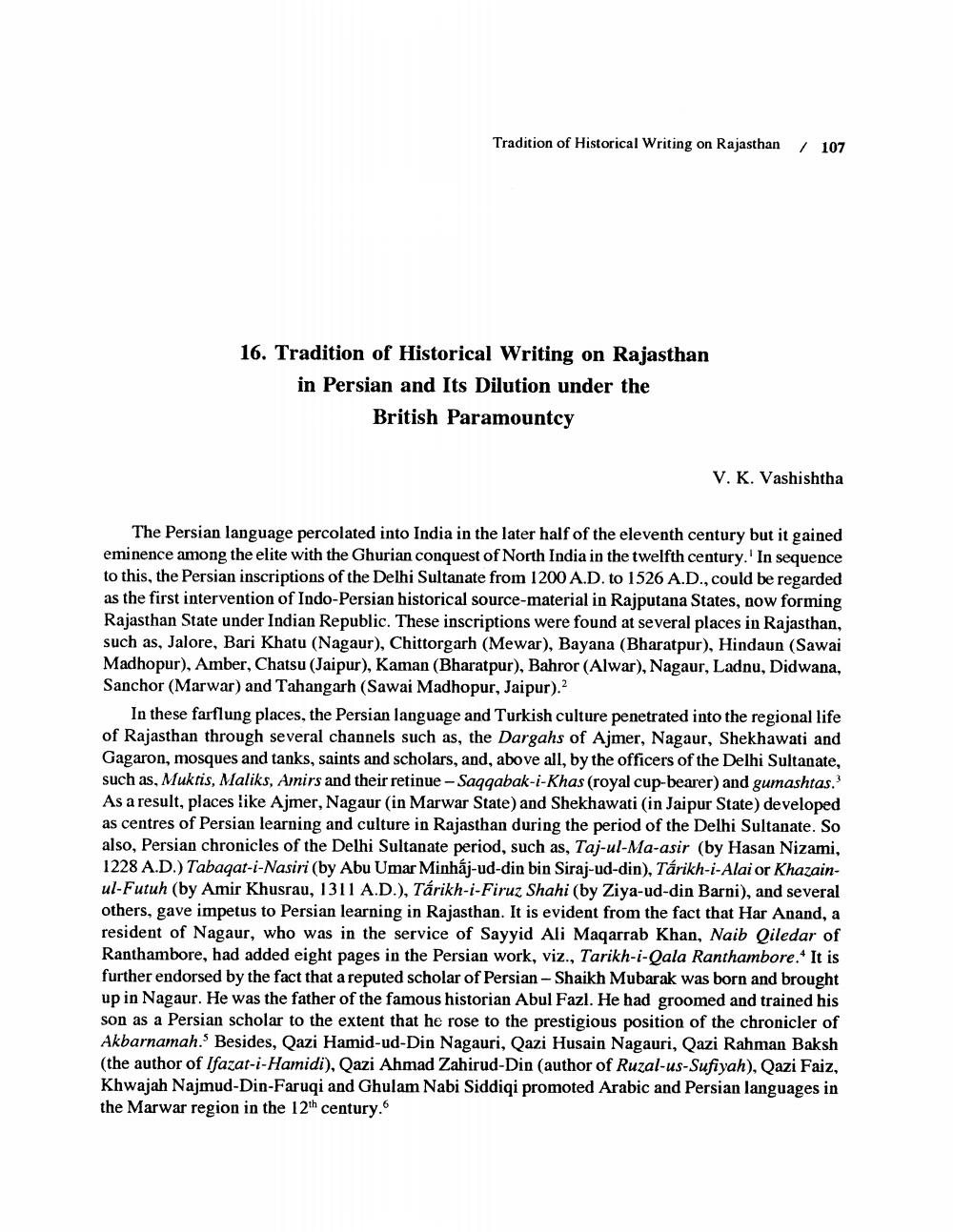________________
Tradition of Historical Writing on Rajasthan / 107
16. Tradition of Historical Writing on Rajasthan
in Persian and Its Dilution under the
British Paramountcy
V. K. Vashishtha
The Persian language percolated into India in the later half of the eleventh century but it gained eminence among the elite with the Ghurian conquest of North India in the twelfth century.' In sequence to this, the Persian inscriptions of the Delhi Sultanate from 1200 A.D. to 1526 A.D., could be regarded as the first intervention of Indo-Persian historical source-material in Rajputana States, now forming Rajasthan State under Indian Republic. These inscriptions were found at several places in Rajasthan, such as, Jalore, Bari Khatu (Nagaur), Chittorgarh (Mewar), Bayana (Bharatpur), Hindaun (Sawai Madhopur), Amber, Chatsu (Jaipur), Kaman (Bharatpur), Bahror (Alwar), Nagaur, Ladnu, Didwana, Sanchor (Marwar) and Tahangarh (Sawai Madhopur, Jaipur)."
In these farflung places, the Persian language and Turkish culture penetrated into the regional life of Rajasthan through several channels such as, the Dargahs of Ajmer, Nagaur, Shekhawati and Gagaron, mosques and tanks, saints and scholars, and, above all, by the officers of the Delhi Sultanate, such as, Muktis, Maliks, Amirs and their retinue - Saqqabak-i-Khas (royal cup-bearer) and gumashtas. As a result, places like Ajmer, Nagaur (in Marwar State) and Shekhawati (in Jaipur State) developed as centres of Persian learning and culture in Rajasthan during the period of the Delhi Sultanate. So also, Persian chronicles of the Delhi Sultanate period, such as, Taj-ul-Ma-asir (by Hasan Nizami, 1228 A.D.) Tabagat-i-Nasiri (by Abu Umar Minhaj-ud-din bin Siraj-ud-din), Tárikh-i-Alai or Khazainul-Futuh (by Amir Khusrau, 1311 A.D.), Tárikh-i-Firuz Shahi (by Ziya-ud-din Barni), and several others, gave impetus to Persian learning in Rajasthan. It is evident from the fact that Har Anand, a resident of Nagaur, who was in the service of Sayyid Ali Maqarrab Khan, Naib Qiledar of Ranthambore, had added eight pages in the Persian work, viz., Tarikh-i-Qala Ranthambore.* It is further endorsed by the fact that a reputed scholar of Persian - Shaikh Mubarak was born and brought up in Nagaur. He was the father of the famous historian Abul Fazl. He had groomed and trained his son as a Persian scholar to the extent that he rose to the prestigious position of the chronicler of Akbarnamah. Besides, Qazi Hamid-ud-Din Nagauri, Qazi Husain Nagauri, Qazi Rahman Baksh (the author of Ifazat-i-Hamidi), Qazi Ahmad Zahirud-Din (author of Ruzal-us-Sufiyah), Qazi Faiz, Khwajah Najmud-Din-Faruqi and Ghulam Nabi Siddiqi promoted Arabic and Persian languages in the Marwar region in the 12th century."




